
Concept explainers
(a)
Interpretation:
A steroid is to be classified as saponifiable or nonsaponifiable lipid.
Concept introduction:
Lipids are one of those macromolecular substances that are present in the living cell. The cell membrane of the living cell is made up of lipids. The lipids have a greasy, waxy and oily texture. The lipids are insoluble in water. They include natural oils, waxes, and steroids.
Answer to Problem 18.4E
A steroid is a nonsaponifiable lipid.
Explanation of Solution
A hydrolysis reaction carried out in a basic solution is known as saponification reaction. The term saponifiable lipids indicate the lipids that can undergo saponification reaction. The lipids that have ester group are saponifiable lipids. The basic structure of steroid is composed of three six-member ring and one five-member ring. The steroid ring system is shown below.
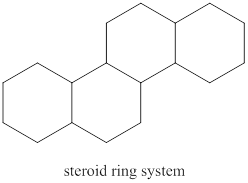
Figure 1
The basic structure of steroid does not have any ester group. Therefore, a steroid is a nonsaponifiable lipid.
A steroid is a nonsaponifiable lipid.
(b)
Interpretation:
Wax is to be classified as saponifiable or nonsaponifiable lipid.
Concept introduction:
Lipids are one of those macromolecular substances that are present in the living cell. The cell membrane of the living cell is made up of lipids. The lipids have a greasy, waxy and oily texture. The lipids are insoluble in water. They include natural oils, waxes, and steroids.
Answer to Problem 18.4E
Wax is a saponifiable lipid.
Explanation of Solution
A hydrolysis reaction carried out in a basic solution is known as saponification reaction. The term saponifiable lipids indicate the lipids that can undergo saponification reaction. The lipids that have ester group are saponifiable lipids. The wax is an ester of long-chain alcohol and a fatty acid. The structure of a simple wax that is beeswax is shown below.
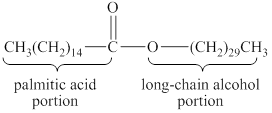
Figure 2
The basic structure of wax has an ester group. Therefore, wax is a saponifiable lipid.
Wax is a saponifiable lipid.
(c)
Interpretation:
A triglyceride is to be classified as saponifiable or nonsaponifiable lipid.
Concept introduction:
Lipids are one of those macromolecular substances that are present in the living cell. The cell membrane of the living cell is made up of lipids. The lipids have a greasy, waxy and oily texture. The lipids are insoluble in water. They include natural oils, waxes, and steroids.
Answer to Problem 18.4E
A triglyceride is a saponifiable lipid.
Explanation of Solution
A hydrolysis reaction carried out in a basic solution is known as saponification reaction. The term saponifiable lipids indicate the lipids that can undergo saponification reaction. The lipids that have ester group are saponifiable lipids. The triglyceride is formed from glycerol and three fatty acids with ester bonds. The general structure of triglyceride is shown below.

Figure 3
The basic structure of triglyceride has ester groups. Therefore, a triglyceride is a saponifiable lipid.
A triglyceride is a saponifiable lipid.
(d)
Interpretation:
A phosphoglyceride is to be classified as saponifiable or nonsaponifiable lipids.
Concept introduction:
Lipids are one of those macromolecular substances that are present in the living cell. The cell membrane of the living cell is made up of lipids. The lipids have a greasy, waxy and oily texture. The lipids are insoluble in water. They include natural oils, waxes, and steroids.
Answer to Problem 18.4E
A phosphoglyceride is a saponifiable lipid.
Explanation of Solution
A hydrolysis reaction carried out in a basic solution is known as saponification reaction. The term saponifiable lipids indicate the lipids that can undergo saponification reaction. The lipids that have ester group are saponifiable lipids. The structure of phosphoglyceride is similar to that of a triglyceride. The only difference between triglyceride and phosphoglyceride is that on the third carbon of glycerol, a phosphate group is attached in the phosphoglyceride. The general structure of phosphoglyceride is shown below.
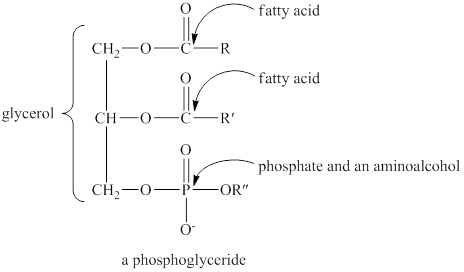
Figure 4
The basic structure of phosphoglyceride has ester groups. Therefore, a phosphoglyceride is a saponifiable lipid.
A phosphoglyceride is a nonsaponifiable lipid.
(e)
Interpretation:
A glycolipid is to be classified as saponifiable or nonsaponifiable lipid.
Concept introduction:
Lipids are one of those macromolecular substances that are present in the living cell. The cell membrane of the living cell is made up of lipids. The lipids have a greasy, waxy and oily texture. The lipids are insoluble in water. They include natural oils, waxes, and steroids.
Answer to Problem 18.4E
A glycolipid is a saponifiable lipid.
Explanation of Solution
A hydrolysis reaction carried out in a basic solution is known as saponification reaction. The term saponifiable lipids indicate the lipids that can undergo saponification reaction. The lipids that have ester group are saponifiable lipids. The glycolipid contains carbohydrate in it. The glycolipids are also termed as cerebroside as they are present in the brain. The typical structure of glycolipid (cerebroside) is shown below.
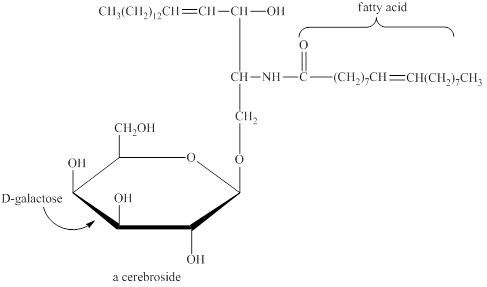
Figure 5
The basic structure of glycolipid does not have an ester group but they have an amide group that can undergo saponification. Therefore, a glycolipid is a saponifiable lipid.
A glycolipid is a saponifiable lipid.
(f)
Interpretation:
A prostaglandin is to be classified as saponifiable or nonsaponifiable lipid.
Concept introduction:
Lipids are one of those macromolecular substances that are present in the living cell. The cell membrane of the living cell is made up of lipids. The lipids have a greasy, waxy and oily texture. The lipids are insoluble in water. They include natural oils, waxes, and steroids.
Answer to Problem 18.4E
Prostaglandin is a nonsaponifiable lipid.
Explanation of Solution
A hydrolysis reaction carried out in a basic solution is known as saponification reaction. The term saponifiable lipids indicate the lipids that can undergo saponification reaction. The lipids that have ester group are saponifiable lipids. The basic structure prostaglandin is composed of a five-member ring with two substituted carbon chain. The structure of prostaglandin
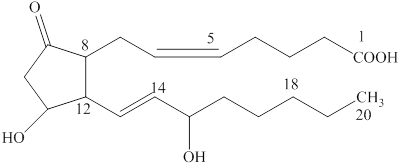
Figure 6
The basic structure of prostaglandin does not have an ester group. Therefore, a prostaglandin is a nonsaponifiable lipid.
Prostaglandin is a nonsaponifiable lipid.
Want to see more full solutions like this?
Chapter 18 Solutions
Chemistry For Today: General, Organic, And Biochemistry, Loose-leaf Version
- pls helparrow_forwardpls helparrow_forward35) Complete the following equation by drawing the line the structure of the products that are formed. Please note that in some cases more than one product is possible. You must draw all possible products to recive full marks! a. ethanol + 2-propanol + H2SO4 → b. OH conc. H2SO4 CH2 H3C CH + K2Cr2O7 C. d. H3C A pressure CH3 + H2 CH Pt catalystarrow_forward
- 21) The rate of reaction depends upon: a. the concentration and nature of reactants b. the temperature of the reaction C. whether or not a catalyst was used d. all of the above 22) A Maxwell-Boltzmann curve shows the distribution of molecular energies in a reaction system. When the temperature in this system is increased, the peak is a. higher and further to the right. b. higher and further to the left. c. lower and further to the right. d. lower and further to the left. 23) Which of the following correctly describes the reaction represented by the reaction below? CaCO3 (s) + energy → CaO (s) + CO2 (g) a. It is exothermic and the potential energy is greater in the reactants than the products. b. c. It is exothermic and the potential energy is greater in the products than the reactants. It is endothermic and the potential energy is greater in the products than the reactants. d. It is endothermic and the potential energy is equal for the products and reactants.arrow_forwardpls helparrow_forward27) Draw the energy level diagram and write the full and shorthand electron configuration for a neutral sulfur atom.arrow_forward
- Indicate whether these compounds are isomers, enantiomers, or tautomers. OCH OCH محمد ممدarrow_forward30) Substance A to E below are listed with several of their properties. The identities of the substances are identified in random order below: Iron, ethane, ethanol, sodium nitrate, graphite First classify each substance as either a polar covalent compound, non-polar covalent compound, ionic compound, metallic solid, or network solid. Write your predictions in the sixth coloumn of the chart, under "type of substance." Then, identify the identity of the substance in the last coloumn. Substance Melting Point Boiling Point Solubility in H₂O Electrical Conductivity Type of Substance Identity of Substance (°C) (°C) as: Solid, Liquids, Solution A -182 -88 Insoluble No/No/- B 1538 2862 Insoluble Yes/Yes/- C 308 380 Soluble Yes/Yes/Yes Ꭰ 3456 Insoluble No/-/- E -114 78 Soluble No/No/Noarrow_forwardpls helparrow_forward
 Chemistry for Today: General, Organic, and Bioche...ChemistryISBN:9781305960060Author:Spencer L. Seager, Michael R. Slabaugh, Maren S. HansenPublisher:Cengage LearningChemistry: Matter and ChangeChemistryISBN:9780078746376Author:Dinah Zike, Laurel Dingrando, Nicholas Hainen, Cheryl WistromPublisher:Glencoe/McGraw-Hill School Pub Co
Chemistry for Today: General, Organic, and Bioche...ChemistryISBN:9781305960060Author:Spencer L. Seager, Michael R. Slabaugh, Maren S. HansenPublisher:Cengage LearningChemistry: Matter and ChangeChemistryISBN:9780078746376Author:Dinah Zike, Laurel Dingrando, Nicholas Hainen, Cheryl WistromPublisher:Glencoe/McGraw-Hill School Pub Co
 World of ChemistryChemistryISBN:9780618562763Author:Steven S. ZumdahlPublisher:Houghton Mifflin College Div
World of ChemistryChemistryISBN:9780618562763Author:Steven S. ZumdahlPublisher:Houghton Mifflin College Div Introductory Chemistry: A FoundationChemistryISBN:9781337399425Author:Steven S. Zumdahl, Donald J. DeCostePublisher:Cengage Learning
Introductory Chemistry: A FoundationChemistryISBN:9781337399425Author:Steven S. Zumdahl, Donald J. DeCostePublisher:Cengage Learning Organic ChemistryChemistryISBN:9781305580350Author:William H. Brown, Brent L. Iverson, Eric Anslyn, Christopher S. FootePublisher:Cengage Learning
Organic ChemistryChemistryISBN:9781305580350Author:William H. Brown, Brent L. Iverson, Eric Anslyn, Christopher S. FootePublisher:Cengage Learning





